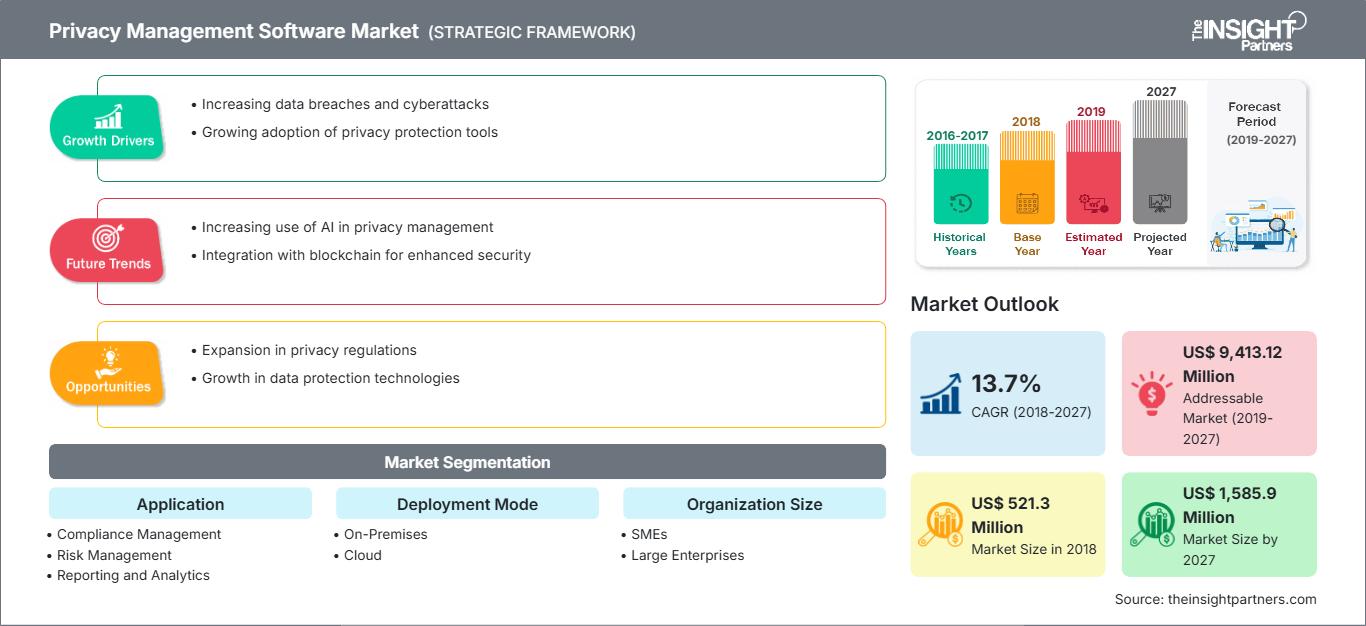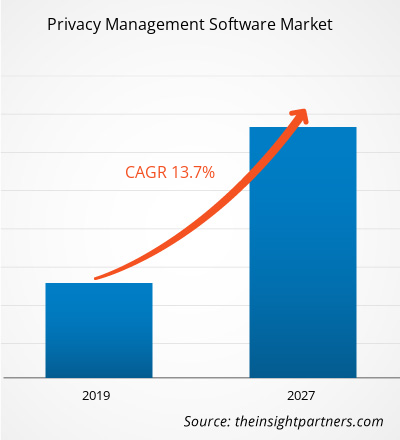El mercado mundial de software de gestión de privacidad alcanzó los 521,3 millones de dólares estadounidenses en 2018 y se espera que crezca a una tasa de crecimiento anual compuesta (TCAC) del 13,7% durante el período de previsión 2019-2027, hasta alcanzar los 1.585,9 millones de dólares estadounidenses en 2027.
Se prevé que Europa sea el mercado de mayor crecimiento y Norteamérica el que más contribuya a los ingresos durante el período de previsión en el mercado de software de gestión de la privacidad. La Comisión Europea publicó una guía para pequeñas y medianas empresas (pymes) con el fin de ayudarlas a cumplir con el próximo Reglamento General de Protección de Datos (RGPD) de la UE. La Comisión Europea también asesora a las pymes sobre las medidas que deben adoptar para cumplir con la normativa, incluyendo la obtención del consentimiento, la comunicación con los interesados, la implementación de la protección de datos desde el diseño y la designación de un delegado de protección de datos (DPD). El gasto total en gestión del cumplimiento normativo registrado en Europa en 2018 superó los 107,9 millones de dólares estadounidenses, lo que se espera que impulse el mercado de software de gestión de la privacidad en esta región.
Perspectivas del mercado
Mayor responsabilidad en la garantía de la seguridad de los datos
Con el creciente volumen y la relevancia de los datos que manejan los sistemas de información modernos, las vulneraciones de la privacidad y la seguridad representan una amenaza cada vez mayor no solo para los usuarios, sino también para los operadores y diseñadores de sistemas. Las organizaciones buscan con urgencia software que les permita realizar sus tareas sin demasiadas interferencias; sin embargo, en caso de mala conducta, el software debe ser capaz de responsabilizar al usuario. La creciente demanda de responsabilidad está, por lo tanto, impulsando a las organizaciones a adoptar software de gestión de la privacidad que les permita maximizar su autonomía y garantizar la rendición de cuentas. Esto impulsará el mercado de software de gestión de la privacidad durante el período previsto.
Obtendrá personalización gratuita de cualquier informe, incluyendo partes de este informe, análisis a nivel de país y paquetes de datos de Excel. Además, podrá aprovechar excelentes ofertas y descuentos para empresas emergentes y universidades.
Mercado de software de gestión de privacidad: Perspectivas estratégicas

-
Obtenga las principales tendencias clave del mercado que se describen en este informe.Esta muestra GRATUITA incluirá análisis de datos, desde tendencias del mercado hasta estimaciones y pronósticos.
La coordinación internacional seguirá siendo, en el mejor de los casos, irregular.
Desde la entrada en vigor del RGPD , el mercado de software de gestión de la privacidad ha visto cómo otras regiones, como California, Sudamérica y Asia Pacífico, han adoptado su propia legislación. Si bien muchos de los borradores y nuevas regulaciones propuestas son menos estrictas que el RGPD , lo ideal sería que la cultura empresarial internacional condujera a un estándar internacional para la privacidad de los datos. En cambio, a nivel global, es muy probable que la aplicación del RGPD influya en la forma en que las empresas internacionales abordan la privacidad de los datos en sus prácticas comerciales. Algunas empresas del sector se han esforzado por aplicar los estándares más rigurosos a nivel global, beneficiando así a todas. Se prevé que otras evalúen los riesgos y actúen por regiones, mientras que otras podrían seguir acatando la normativa de forma superficial debido al número limitado de casos en los que se han impuesto sanciones significativas. Esta tendencia anticipa el crecimiento del mercado de software de gestión de la privacidad durante el período de previsión.
Perspectivas de la industria
El mercado global de software de gestión de privacidad, segmentado por sector industrial, estuvo liderado por el sector de banca, servicios financieros y seguros (BFSI). Otros sectores considerados en este mercado incluyen telecomunicaciones y TI, BFSI, gobierno y defensa, entre otros.
Información de la aplicación
El mercado de software de gestión de privacidad, segmentado por aplicación, incluye gestión de cumplimiento, gestión de riesgos, informes y análisis, y otros. El software de cumplimiento de privacidad se ha convertido en una herramienta indispensable para generar programas de privacidad eficaces que integran diversas leyes y regulaciones. Además, la creciente preocupación por la privacidad entre los consumidores ha impactado su confianza en las organizaciones que les prestan servicios. Asimismo, las personas están empezando a comprender que sus datos son vulnerables a ser compartidos sin su consentimiento y exigen que las organizaciones asuman la responsabilidad de protegerlos y cumplan con las nuevas regulaciones de privacidad. Se espera que esto genere una importante oportunidad de crecimiento para los principales actores del mercado de software de gestión de privacidad.
Se observó que las nuevas iniciativas de mercado eran la estrategia más adoptada en el mercado global de software de gestión de privacidad. A continuación, se enumeran algunas de las iniciativas de mercado recientes:
2019: BigID anunció su asociación con Immuta para ofrecer una solución integrada para la automatización de iniciativas de ciencia de datos centradas en la privacidad.
2019: OneTrust completó la adquisición de DataGuidance. Gracias a la integración de OneTrust y DataGuidance, los clientes tienen acceso a información práctica sobre los cambios en los marcos legales y de cumplimiento normativo a nivel mundial, así como a herramientas para ejecutar y supervisar dicho cumplimiento.
2018: El Everton FC seleccionó la suite GDPR de SureCloud. La empresa ofreció al club su conjunto de soluciones en la nube con el objetivo de controlar y supervisar los datos y el cumplimiento del RGPD.
Perspectivas regionales del mercado de software de gestión de privacidad
Los analistas de The Insight Partners han explicado en detalle las tendencias y los factores regionales que influyen en el mercado de software de gestión de privacidad durante el período de previsión. Esta sección también analiza los segmentos y la geografía del mercado de software de gestión de privacidad en Norteamérica, Europa, Asia Pacífico, Oriente Medio y África, y Sudamérica y Centroamérica.
Alcance del informe de mercado de software de gestión de privacidad
| Atributo del informe | Detalles |
|---|---|
| Tamaño del mercado en 2018 | 521,3 millones de dólares estadounidenses |
| Tamaño del mercado para 2027 | 1.585,9 millones de dólares estadounidenses |
| Tasa de crecimiento anual compuesto global (2018 - 2027) | 13,7% |
| Datos históricos | 2016-2017 |
| Período de pronóstico | 2019-2027 |
| Segmentos cubiertos |
Por aplicación
|
| Regiones y países cubiertos |
América del norte
|
| Líderes del mercado y perfiles de empresas clave |
|
Densidad de los actores del mercado de software de gestión de privacidad: comprensión de su impacto en la dinámica empresarial
El mercado de software de gestión de privacidad está creciendo rápidamente, impulsado por la creciente demanda de los usuarios finales debido a factores como la evolución de las preferencias de los consumidores, los avances tecnológicos y una mayor conciencia de los beneficios del producto. A medida que aumenta la demanda, las empresas amplían su oferta, innovan para satisfacer las necesidades de los consumidores y aprovechan las tendencias emergentes, lo que impulsa aún más el crecimiento del mercado.

- Obtenga una visión general de los principales actores del mercado de software de gestión de privacidad.
SOFTWARE DE GESTIÓN DE PRIVACIDAD GLOBAL – SEGMENTACIÓN DE MERCADO
Por tipo de implementación
- En las instalaciones
- Nube
Por tamaño de la organización
- Pequeñas y medianas empresas
- Gran empresa
Por aplicación
- Gestión del cumplimiento
- Gestión de riesgos
- Informes y análisis
- Otros
Por sector industrial vertical
- Telecomunicaciones e informática
- BFSI
- Gobierno y Defensa
- Otros
Por geografía
-
América del norte
- A NOSOTROS
- Canadá
- México
-
Europa
- Francia
- Alemania
- Italia
- Países Bajos
- Reino Unido
- El resto de Europa
-
Asia Pacífico (APAC)
- Taiwán
- Porcelana
- India
- Corea del Sur
- Japón
- Resto de Asia Pacífico
-
Oriente Medio y África (MEA)
- Sudáfrica
- Arabia Saudita
- Emiratos Árabes Unidos
- Resto de Oriente Medio y África
-
Sudamérica (SAM)
- Brasil
- Argentina
- El resto de SAM
Perfiles de empresas
- AvePoint, Inc.
- BigID, Inc.
- Corporación IBM
- Nymity Inc.
- OneTrust, LLC
- Protiviti Inc.
- RSA Security LLC
- LogicGate, Inc.
- SureCloud
- TrustArc Inc.
- Análisis histórico (2 años), año base, pronóstico (7 años) con CAGR
- Análisis PEST y FODA
- Tamaño del mercado, valor/volumen: global, regional y nacional
- Industria y panorama competitivo
- Conjunto de datos de Excel
Informes recientes
Informes relacionados
Testimonios
Razón para comprar
- Toma de decisiones informada
- Comprensión de la dinámica del mercado
- Análisis competitivo
- Información sobre clientes
- Pronósticos del mercado
- Mitigación de riesgos
- Planificación estratégica
- Justificación de la inversión
- Identificación de mercados emergentes
- Mejora de las estrategias de marketing
- Impulso de la eficiencia operativa
- Alineación con las tendencias regulatorias






















 Obtenga una muestra gratuita para - Mercado de software de gestión de la privacidad
Obtenga una muestra gratuita para - Mercado de software de gestión de la privacidad